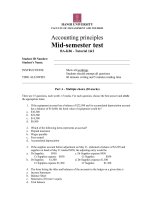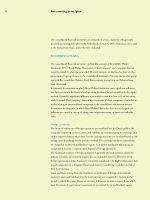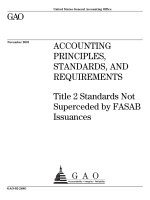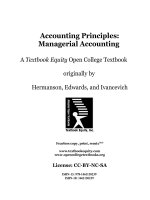Accounting principles
Bạn đang xem bản rút gọn của tài liệu. Xem và tải ngay bản đầy đủ của tài liệu tại đây (736.93 KB, 41 trang )
Accounting Principles, 7th Edition
Weygandt • Kieso • Kimmel
Chapter 12
Accounting
Principles
Prepared by Naomi Karolinski
Monroe Community College
and
Marianne Bradford
Bryant College
John Wiley & Sons, Inc. © 2005
CHAPTER 12
ACCOUNTING
PRINCIPLES
After studying this chapter, you should be able to:
1 Explain the meaning of generally accepted
accounting principles and identify the key
items of the conceptual framework.
2 Describe the basic objectives of financial
reporting.
3 Discuss the qualitative characteristics of
accounting information and elements of
financial statements.
CHAPTER 12
ACCOUNTING
PRINCIPLES
After studying this chapter, you should be able to:
4 Identify the basic assumptions used by
accountants.
5 Identify the basic principles of accounting.
6 Identify the two constraints in accounting.
7 Explain the accounting principles used in
international operations.
CONCEPTUAL
FRAMEWORK OF
ACCOUNTING
STUDY OBJECTIVE 1
• Generally accepted
accounting principles
– set of standards and rules that are recognized as a general
guide for financial reporting
• Generally accepted
– means that these principles must have substantial
authoritative support
• Financial Accounting Standards Board (FASB)
and Securities and Exchange Commission (SEC)
• The FASB has the responsibility for developing
accounting principles in the United States.
FASB’S CONCEPTUAL
FRAMEWORK
• The conceptual framework developed by the
FASB serves as the basis for resolving accounting
and reporting problems.
• The conceptual framework consists of:
1) objectives of financial reporting;
2) qualitative characteristics of
accounting information;
3) elements of financial statements; and
4) operating guidelines (assumptions,
principles, and constraints).
OBJECTIVES OF FINANCIAL
REPORTING
STUDY OBJECTIVE 2
FASB objectives of financial reporting are
to provide information that is:
1 useful to those making investment
and credit decisions
2 helps in assessing future cash flows
3 identifies the economic resources (assets),
the claims to those resources (liabilities),
and the changes in those resources and
claims
QUALITATIVE
CHARACTERISTICS OF
ACCOUNTING INFORMATION
STUDY OBJECTIVE 3
To be useful, information should possess
the following qualitative characteristics:
1 relevance
2 reliability
3 comparability
4 consistency
RELEVANCE
• Accounting information has relevance if
it makes a difference in a decision.
• Relevant information helps users forecast
future events (predictive value),
or it confirms or corrects prior
expectations (feedback value).
• Information must be available
to decision makers before it
loses its capacity to influence
their decisions (timeliness).
RELIABILITY
•
•
Reliability of information means that the
information is free of error and bias, in
short, it can be depended on.
To be reliable, accounting information
must be verifiable.
COMPARABILITY AND
CONSISTENCY
•
•
Comparability means that the information should be
comparable with accounting information about other
enterprises.
Consistency means that the same accounting principles
and methods should be used from year to year within a
company.
2005
2006
2007
QUALITATIVE
CHARACTERISTICS OF
ACCOUNTING INFORMATION
Useful
Financial
Information has:
Relevance
Reliability
1 Predictive value
1 Verifiable
2 Feedback value
2 Faithful representation
3 Timeliness
3 Neutral
Comparability
Consistency
CHARACTERISTICS OF
USEFUL INFORMATION
THE OPERATING GUIDELINES
OF ACCOUNTING
• Operating guidelines are classified as
assumptions, principles, and constraints.
• Assumptions provide a foundation for the accounting
process.
• Principles indicate how transactions and other economic
events should be recorded.
• Constraints on the accounting process allow for a relaxation
of the principles under certain circumstances.
Assumptions
Monetary unit
Economic entity
Time period
Going concern
Principles
Revenue recognition
Matching
Full disclosure
Cost
Constraints
Materiality
Conservatism
ASSUMPTIONS
USED IN ACCOUNTING
The primary criterion by which accounting
information can be judged is:
a. consistency.
b. predictive value.
c. decision-usefulness.
d. comparability.
The primary criterion by which accounting
information can be judged is:
a. consistency.
b. predictive value.
c. decision-usefulness.
d. comparability.
ASSUMPTIONS
STUDY OBJECTIVE 4
Monetary unit assumption:
– only transaction data expressed in terms of money can be
included in the accounting records
Example: employee satisfaction and percent of
international employees are not transactions that
should be included in the financial records.
Customer Satisfaction
Percentage of
International Employees
Should be included
in accounting records
Salaries paid
ECONOMIC
ENTITY
ASSUMPTION
Activities of
the entity kept separate
and distinct from the activities of the owner
and all other economic entities.
Example: BMW activities
can be distinguished from
those of other car
manufacturers such as Mercedes.
TIME PERIOD
ASSUMPTION
Economic life of a business divided into
artificial time periods.
2005
QTR 1
QTR 2
QTR 3
QTR 4
2006
JAN
APR
JUL
OCT
FEB
MAY
AUG
NOV
2007
MAR
JUN
SEPT
DEC
GOING
CONCERN
ASSUMPTION
Enterprise will continue in operation long
enough to carry out its existing objectives.
Implications: depreciation and amortization
are used, plant assets recorded at cost instead
of liquidation value, items are labeled as fixed
or long-term.
•
•
PRINCIPLES
REVENUE
RECOGNITION
Revenue recognition
principle
STUDY OBJECTIVE
5
dictates that revenue should be
recognized in the accounting
period in which it is earned.
When a sale is involved, revenue is
recognized at the point of sale.
PERCENTAGE-OFCOMPLETION METHOD OF
REVENUE RECOGNITION
• In long-term construction contracts, revenue
recognition is usually required before the contract is
completed.
• The percentage-of-completion method recognizes
revenue on the basis of reasonable estimates of
progress toward completion.
• A project’s progress toward completion is
measured by comparing the costs incurred in a
year to total estimated costs of the entire
project.
FORMULA TO RECOGNIZE REVENUE IN
THE PERCENTAGE-OF-COMPLETION METHOD
Costs Incurred
(Current
Period)
Percent
Complete
(Current
Period)
÷
X
Total
Estimated
Cost
Total Revenue
=
=
Percent
Complete
(Current
Period)
Revenue
Recognized
(Current
Period)
FORMULA TO COMPUTE GROSS
PROFIT
IN CURRENT PERIOD
The costs incurred in the current period are then
subtracted from the revenue recognized during the
current period to arrive at the gross profit.
Revenue
Recognized
(Current
Period)
X
Cost Incurred
(Current
Period)
=
Gross Profit
Recognized
(Current
Period)
REVENUE RECOGNIZED
PERCENTAGE-OF-COMPLETION
METHOD
Warrior Construction Co. has a contract to build a dam for $400
million. It will take 3 years (starting in 2005) at a construction cost of
$360 million. Assume that Warrior incurs $54 million in 2005, $180
million in 2006, and $126 million in 2007 on the dam project. The
portion of the $400 million of revenue recognized in each of the 3
years is shown below:









